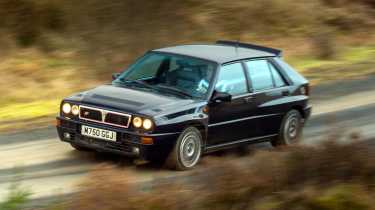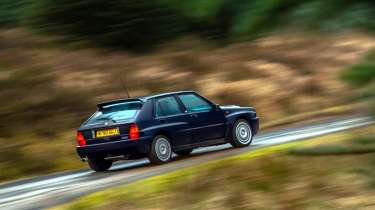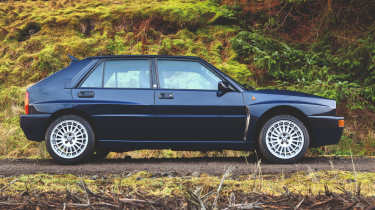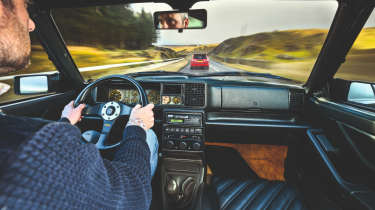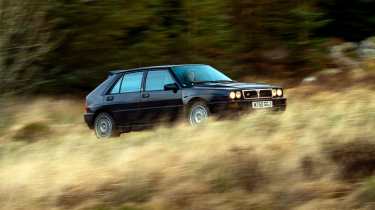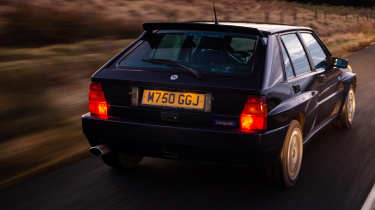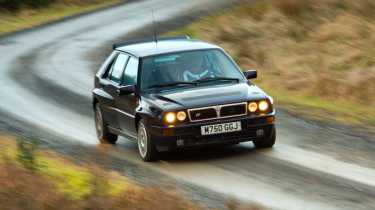Lancia Delta Integrale (1987 - 1994) – history, review and specs of Italy's rally icon
Hugely successful in its day, the Integrale’s appeal is just as strong now as it was back in the late ‘80s
While Group B spawned the most extreme rally cars the world’s ever seen, its Group A World Rally Championship successor produced some iconic road cars and perhaps none more so than the Lancia Delta Integrale. Success on the stages doesn’t always equate to greatness on the road, but in the case of the Integrale it absolutely nailed it in both arenas. In competition, it had 46 WRC wins, six Constructors’ Championships and four drivers’ crowns – two for Juha Kankkunen and two for Miki Biasion.
The passage of time can turn heroes into has-beens. Not so the Lancia Delta HF Integrale. Even today, over 30 years after the original 8-valve Integrale was launched, it’s still a rewarding machine to drive. We’re not going to pretend that it will erupt out of corners with the savage rage of a Mercedes-AMG A45 S or be quite as quick point to point, but you’ll no doubt have a more interactive and involving experience in the Integrale.
Lancia Delta Integrale in detail
There’s something just so intrinsically right about a car with boxy, blistered wheelarches – BMW E30 M3, Audi Quattro and, of course, the Integrale – they speak of extensive modifications to elevate the relatively mundane to the pinnacle of performance and that’s exactly what Lancia did with the humble Delta.
More reviews
> BMW E30 M3 v E46 M3 CSL v F87 M2 CS – M Division icons through the generations
FISA’s mid-season announcement in 1986 of the switch in regulations from B to A for the following year didn’t leave much time for manufacturers to adjust. However, Lancia already had a car ideal for rallying: the Delta HF 4WD. It had been unveiled at the 1986 Turin motor show, ironically just a month before Henri Toivonen’s demise.
Originally launched in 1979, the five-door Delta was, like many of its contemporaries, refined during its life and eventually spawned a hot version, the Delta High Fidelity (HF), with a turbocharged 1.6-litre engine. By 1986 this had morphed into the HF Turbo AWD featuring a 2-litre turbocharged ’four and, crucially, four-wheel drive. Lancia unwittingly had a winner already sitting in its showrooms. It won nine out of the 13 rounds in 1987, bagging both the constructors’ and drivers’ titles.
Lancia more or less had it all its own way for the next three years but inevitably the opposition started to catch up, so Lancia refined the concept and launched the Delta HF Integrale 8v boasting a host of revisions over the AWD model. The transversely mounted 2-litre received a bigger Garrett turbocharger to produce 182bhp and 224lb ft, while wheels, tyres and brakes were all larger, along with revised springs, dampers and front struts. To accommodate the bigger wheels and suspension revisions the iconic blistered arches made their debut, too.
Further changes came in 1989 when the 16v model was introduced – identifiable by its raised bonnet line to accommodate the engine – and power was now up to 197bhp. The best was yet to come though and that was the Evoluzione (generally shortened to Evo) which made its debut in 1991 and offered the most comprehensive of makeovers.
While the engine wasn’t substantially changed, power increased again to 207bhp, but revisions to its suspension ensured its competitive edge was retained. There were box section track control arms, the front strut towers were raised, and the front and rear tracks were widened, necessitating the use of even more heavily blistered wheelarches and larger, 16-inch Speedline alloys. The front and rear bumpers were toughened up and widened to blend with the extended arches and there was an adjustable spoiler to sit at the top of the tailgate.
The last of the line – excluding the special editions which were primarily concerned with extending the Integrale’s rather restrictive colour palette – was the Evo II, effectively an Evo but fitted with a catalytic converter and some engine tweaks to make up for any horses that had been reined in by the cat.
While it’s the Evo models that have become the most coveted, an Integrale in any of its incarnations is a glorious machine. Its clever four-wheel-drive set-up gave it limpet-like grip whatever the weather, but like the rest of the car it was tweaked during its lifetime.
Derived from the system seen on the mid-engined S4 Group B car, initially it was a front-biased set-up distributing power 56 per cent to the front and 44 per cent to the back, but increasingly this became more rear biased – 47 front and 53 to the rear on later versions. A centre diff directed the torque based on these ratios until a Ferguson viscous coupling detected wheel slip, diverting power to the wheels that were best placed to deploy it, while a Torsen rear diff could vary the amount of power being sent to the individual rear wheels, too.
Inside there were constant tweaks and revisions, with sports seats and the optional Recaros (fitted as standard to the Evo cars in most markets) being clad in a mixture of cloth, Alcantara and leather depending on the market and the option boxes ticked. One constant was the typical Italian driving position which didn’t suit all drivers and there was a feeling of being perched on the car rather than sitting low down as you might expect from such a sporting proposition.
The dash is classic 1980s with a squared off binnacle featuring a plethora of dials and gauges sitting alongside the expected speedo and rev counter. Decorated in yellow script with yellow needles, they were a distinctive feature of the car.
Lancia Delta Integrale specs (Evo II)
| Engine | In-line 4-cyl, 1995cc, turbo |
| Power | 212bhp @ 5750rpm |
| Torque | 232lb ft @ 2500rpm |
| Weight | 1340kg |
| Power-to-weight | 161bhp/ton |
| 0-62mph | 5.7sec (claimed) |
| Top speed | 137mph (claimed) |
| Price | £25,000 (1993) |
What we said
‘The fabled Lancia is one of those cars on the list of things I’ve desperately wanted to drive for a very, very long time. And now here I am, perched on a sumptuously trimmed leather Recaro seat looking at one of the most recognisable dashboards ever made. Those dials… those yellow dials, like someone’s got carried away with a school protractor set and a gel pen. I think I’m in love with it already.
‘When I say ‘perched’, I really mean it, because the Integrale’s driving position is how you might imagine it to be: resolutely Italian and ergonomically haphazard. The wheel is laid noticeably flat, and I feel like I’m peering under the tops of the window frames to see out; this, and the angular dashboard architecture, betray a car that in its fundamental form went on sale at the end of the 1970s.
‘Which in some ways makes its ability, even more than its latent charm, the biggest surprise. After the crudity of the Cosworth and the hyperactive rawness of the Subaru, the Integrale feels a more rounded proposition, overlaid with a certain Italian flamboyance that the other cars here could never even begin to comprehend. I mean, the Lancia has deep tan carpeting, for starters, and its sculpted exterior panels are as suave as they are purposeful.
‘Still, it really gets up and goes, the Lancia. There’s not that much lag, and the classic twin cam is smooth and distinctive in voice, if not overly loud: there’s none of the deep, ripping gargle that characterised the Group A versions with Torino number plates. The most obvious dynamic difference is that the Integrale feels more conventional, and that it needs a fraction longer to get turned in than some of the scalpel-sharp nutjobs from the Far East…
'The gorgeous Momo Corse wheel needs more working on corner entry, and there’s a perceptible sensation of the car settling initially and adopting a stance before cornering can begin. At first I find it a little unnerving given the slippery, muddy asphalt underneath us, a small spike of adrenaline that car and driver are about to get familiar with the scenery head-on.
But once you’ve learnt that it’s simply how the Lancia goes about its work, and that traction is superb from there on in, the confidence begins to build, and using the brakes more on entry seems to help, too.’ – Adam Towler, evo 271 'Group A icons
Buying guide and check points
By the end of its production run in 1994 Lancia had produced nigh on 45,000 Integrales but despite once being a relatively common sight their numbers have dwindled significantly over the years and the best of the best are now commanding six figure sums.
The most coveted are the Evo, Evo II and the run out special edition models and these generate the highest prices. The 8v cars are becoming thin on the ground but the 16v versions still offer decent value for money. Good, usable examples come in at around the £25k mark – they might not be concours, but they should have plenty of life left in them.
It’s important to remember that the oldest examples aren’t far off from celebrating their 40th birthdays and the youngest are over 30 now. These cars will need work of some description so it’s always best to buy the best you can afford. They’re not desperately complicated but have any prospective purchase inspected by a marque specialist if possible – it will be money very well spent in the long run.
While an Integrale won’t rust as badly as a 1970s Lancia Beta it’s not immune to corrosion. Suspension turrets, doors, wings, windscreen pillars and the rear roof section are all known weak points. Many were abused earlier in their lives so check for poorly repaired accident damage, too. It’s also worth noting that it’s not unheard of for unscrupulous sellers to dress up an 8v or 16v to look like an Evo or Evo II.
Regular maintenance is the key to keeping the four-cylinder healthy so check for a set of invoices detailing its history. Snapping cambelts cause a lot of damage and should be replaced every three years or 24,000 to 36,000 miles depending on model. It pays to replace the water pump at the same time. Also bear in mind that uprated camshafts and turbos with higher boost settings will put additional stress on the cambelt. Blue smoke on acceleration or on the overrun could indicate a turbo that’s on its last legs or worn valve stem seals.
Gearboxes tend to pretty durable but check the clutch bite point isn’t too high and that all ratios slot in smoothly without graunching and that the ‘box doesn’t whine while driving. Gearbox repairs will require it to come out of the car. Fortunately the Torsen differential tends to be pretty bullet proof.
It’s likely that most Integrale’s will need some work on their suspension – bushes, bearings and ball joints inevitably wear over time. Part of the joy of an Integrale is its road manners so you need the underpinnings to be in a good state to get the most out of one. The good news is that items like consumable suspension parts and brakes aren’t too expensive and, for the most part, available.
Interiors are durable when judged by Italian standards of the day, but plastic trims can become brittle with age and dashboards can crack, especially if the car you’re looking at has come from a warmer climate.
